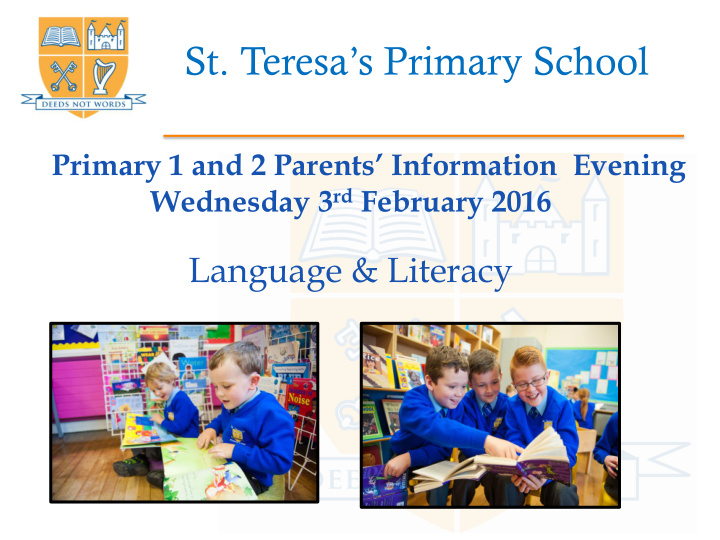



St. Teresa’s Primary School Primary 1 and 2 Parents’ Information Evening Wednesday 3 rd February 2016 Language & Literacy
Shared and Modelled Reading in P1 & 2 Mrs Branniff’s Class Mrs Walsh’s Class Mrs Finch’s Class Mrs Conlon’s Class Mrs Kelly- Bogue’s Class Miss Campbell’s Class Mrs Keane’s Class
Supporting Reading at Home • Read stories to your children daily Story Telling booklet with prompts • Homework activities with your child • Online stories e.g. Starfall • Audio story tapes • Visit your local library • Tablet/smart phone Apps
What is Phonics? • Developing listening skills. • Teaching the sounds of the letters and the names. • A practical approach to learning.
How do we do this? • By the end of each week, your child will have met some new sounds. • Each sound has its own action, story and song • The children listen for the sound. • Letter formation See Action Booklet
Learning the Letter Sounds
Learning the Basic Sounds • s – so • r – red • a – at • m – my • t – to • d – day • i – in • g – go • p – pig • o – on • n – no • u – up • c/k – key • l – lip • e – egg • f – fan • h – hop • b - bee
Moving on to the next stages... • ai - day v – van • j – jug • • oo – boot • oa – oat • oo – zoo • ie – tie y – you • ee – tee • • x – fox (ks) • or – or ch – chair • z – zoo • • sh – shoe • w – we • th – the • ng – rang These are harder to learn: The old saying ‘ When two vowels go walking the first sound does the talking’ m ay help you remember. (ai, oa, ie. ee, ue)
And finally – two letters-one sound • qu – quack • ou – ouch • oi – oil • ue – queue • er – mixer • ar – car
Segmenting Now that we know our sounds .... Segmenting We call the dots sound buttons. Every time we touch the button we say the sound. This is Segmenting
Blending • After Segmenting we put the sounds back together called Blending . Blending is the more difficult skill . • • Some children take longer than others to develop this skill – it improves with practice . • Say the first sound more loudly and repeat the sounds getting faster • Once children have developed the skills of segmenting and blending to help them to read words. They can progress to identifying the sounds in words which will ultimately help them both READ and WRITE View Video
Hearing the Sounds in Words Sound Talk Games -I spy a d-o-g. -Dress the teddy with a c-oa-t. -Give the robot a p-e-g. - Simon says, “Put you hands on your h -ea- d.” -Magnetic letters or squares of paper - Play ‘Show Me’ Sounds - Robot arms/ sound buttons -Letter/ sound Hunts -Alphablocks ( cbeebies)
Tricky Words • Words that do not follow the rules- the here was These are High Frequency Words Learn as look and Say words
Jolly Phonics at home with the Website and Apps • Jolly Phonics Website http://www.jollylearning.co.uk/overview-about- jolly-phonics https://www.youtube.com/watch?v=eCjJYB07a SU • Jolly Phonics App 1. Letter and Sounds- £4.99 through app store for apple or Google play store for android 1. Jolly Phonics Games Bundle- £5.99 2. Pirate phonics 1- £2.29 3. Phonics puzzles-Free 4. Phonics Match-Free
How Writing Develops • Developing control of large movements. • Mastering control of co- ordination and small movements. • Sorting, matching and identifying shapes and patterns. • Beginning to form letters.
St Teresa’s Letter Formation
Writing in Primary 2
Supporting Writing at Home • Model and share writing experiences with your child. • Encourage the development of skills that support writing (large/small movements). • Praise your child for ‘having a go’. • Talk about your child’s writing or mark making.
Recommend
More recommend